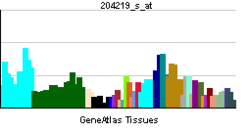PSMC1
26S protease regulatory subunit 4 is an enzyme that in humans is encoded by the PSMC1 gene.[1][2]
Function
The 26S proteasome is a multicatalytic proteinase complex with a highly ordered structure composed of 2 complexes, a 20S core and a 19S regulator. The 20S core is composed of 4 rings of 28 non-identical subunits; 2 rings are composed of 7 alpha subunits and 2 rings are composed of 7 beta subunits. The 19S regulator is composed of a base, which contains 6 ATPase subunits and 2 non-ATPase subunits, and a lid, which contains up to 10 non-ATPase subunits. Proteasomes are distributed throughout eukaryotic cells at a high concentration and cleave peptides in an ATP/ubiquitin-dependent process in a non-lysosomal pathway. An essential function of a modified proteasome, the immunoproteasome, is the processing of class I MHC peptides. This gene encodes one of the ATPase subunits, a member of the triple-A family of ATPases which have a chaperone-like activity. This subunit and a 20S core alpha subunit interact specifically with the hepatitis B virus X protein, a protein critical to viral replication. This subunit also interacts with the adenovirus E1A protein and this interaction alters the activity of the proteasome. Finally, this subunit interacts with ataxin-7, suggesting a role for the proteasome in the development of spinocerebellar ataxia type 7, a progressive neurodegenerative disorder.[2]
Interactions
PSMC1 has been shown to interact with PSMD2[3][4] and PSMC2.[4][5]
References
- ↑ Tanahashi N, Suzuki M, Fujiwara T, Takahashi E, Shimbara N, Chung CH et al. (March 1998). "Chromosomal localization and immunological analysis of a family of human 26S proteasomal ATPases". Biochem Biophys Res Commun 243 (1): 229–32. doi:10.1006/bbrc.1997.7892. PMID 9473509.
- ↑ 2.0 2.1 "Entrez Gene: PSMC1 proteasome (prosome, macropain) 26S subunit, ATPase, 1".
- ↑ Rual JF, Venkatesan K, Hao T, Hirozane-Kishikawa T, Dricot A, Li N et al. (October 2005). "Towards a proteome-scale map of the human protein-protein interaction network". Nature 437 (7062): 1173–8. doi:10.1038/nature04209. PMID 16189514.
- ↑ 4.0 4.1 Gorbea C, Taillandier D, Rechsteiner M (January 2000). "Mapping subunit contacts in the regulatory complex of the 26 S proteasome. S2 and S5b form a tetramer with ATPase subunits S4 and S7". J. Biol. Chem. 275 (2): 875–82. doi:10.1074/jbc.275.2.875. PMID 10625621.
- ↑ Hartmann-Petersen R, Tanaka K, Hendil KB (February 2001). "Quaternary structure of the ATPase complex of human 26S proteasomes determined by chemical cross-linking". Arch. Biochem. Biophys. 386 (1): 89–94. doi:10.1006/abbi.2000.2178. PMID 11361004.
Further reading
- Coux O, Tanaka K, Goldberg AL (1996). "Structure and functions of the 20S and 26S proteasomes.". Annu. Rev. Biochem. 65: 801–47. doi:10.1146/annurev.bi.65.070196.004101. PMID 8811196.
- Goff SP (2003). "Death by deamination: a novel host restriction system for HIV-1.". Cell 114 (3): 281–3. doi:10.1016/S0092-8674(03)00602-0. PMID 12914693.
- Dubiel W, Ferrell K, Pratt G, Rechsteiner M (1992). "Subunit 4 of the 26 S protease is a member of a novel eukaryotic ATPase family.". J. Biol. Chem. 267 (32): 22699–702. PMID 1429620.
- Winkelmann DA, Kahan L (1983). "Immunochemical accessibility of ribosomal protein S4 in the 30 S ribosome. The interaction of S4 with S5 and S12.". J. Mol. Biol. 165 (2): 357–74. doi:10.1016/S0022-2836(83)80261-7. PMID 6188845.
- Maruyama K, Sugano S (1994). "Oligo-capping: a simple method to replace the cap structure of eukaryotic mRNAs with oligoribonucleotides.". Gene 138 (1–2): 171–4. doi:10.1016/0378-1119(94)90802-8. PMID 8125298.
- Seeger M, Ferrell K, Frank R, Dubiel W (1997). "HIV-1 tat inhibits the 20 S proteasome and its 11 S regulator-mediated activation". J. Biol. Chem. 272 (13): 8145–8. doi:10.1074/jbc.272.13.8145. PMID 9079628.
- Suzuki Y, Yoshitomo-Nakagawa K, Maruyama K, Suyama A, Sugano S (1997). "Construction and characterization of a full length-enriched and a 5'-end-enriched cDNA library". Gene 200 (1–2): 149–56. doi:10.1016/S0378-1119(97)00411-3. PMID 9373149.
- Dai RM, Chen E, Longo DL, Gorbea CM, Li CC (1998). "Involvement of valosin-containing protein, an ATPase Co-purified with IkappaBalpha and 26 S proteasome, in ubiquitin-proteasome-mediated degradation of IkappaBalpha". J. Biol. Chem. 273 (6): 3562–73. doi:10.1074/jbc.273.6.3562. PMID 9452483.
- Madani N, Kabat D (1998). "An endogenous inhibitor of human immunodeficiency virus in human lymphocytes is overcome by the viral Vif protein". J. Virol. 72 (12): 10251–5. PMC 110608. PMID 9811770.
- Simon JH, Gaddis NC, Fouchier RA, Malim MH (1998). "Evidence for a newly discovered cellular anti-HIV-1 phenotype". Nat. Med. 4 (12): 1397–400. doi:10.1038/3987. PMID 9846577.
- Gorbea C, Taillandier D, Rechsteiner M (2000). "Mapping subunit contacts in the regulatory complex of the 26 S proteasome. S2 and S5b form a tetramer with ATPase subunits S4 and S7". J. Biol. Chem. 275 (2): 875–82. doi:10.1074/jbc.275.2.875. PMID 10625621.
- Zhang Z, Torii N, Furusaka A, Malayaman N, Hu Z, Liang TJ (2000). "Structural and functional characterization of interaction between hepatitis B virus X protein and the proteasome complex". J. Biol. Chem. 275 (20): 15157–65. doi:10.1074/jbc.M910378199. PMID 10748218.
- Mulder LC, Muesing MA (2000). "Degradation of HIV-1 integrase by the N-end rule pathway". J. Biol. Chem. 275 (38): 29749–53. doi:10.1074/jbc.M004670200. PMID 10893419.
- Turnell AS, Grand RJ, Gorbea C, Zhang X, Wang W, Mymryk JS et al. (2000). "Regulation of the 26S proteasome by adenovirus E1A". EMBO J. 19 (17): 4759–73. doi:10.1093/emboj/19.17.4759. PMC 302057. PMID 10970867.
- Hartmann-Petersen R, Tanaka K, Hendil KB (2001). "Quaternary structure of the ATPase complex of human 26S proteasomes determined by chemical cross-linking". Arch. Biochem. Biophys. 386 (1): 89–94. doi:10.1006/abbi.2000.2178. PMID 11361004.
- Matilla A, Gorbea C, Einum DD, Townsend J, Michalik A, van Broeckhoven C et al. (2002). "Association of ataxin-7 with the proteasome subunit S4 of the 19S regulatory complex". Hum. Mol. Genet. 10 (24): 2821–31. doi:10.1093/hmg/10.24.2821. PMID 11734547.
- Sheehy AM, Gaddis NC, Choi JD, Malim MH (2002). "Isolation of a human gene that inhibits HIV-1 infection and is suppressed by the viral Vif protein". Nature 418 (6898): 646–50. doi:10.1038/nature00939. PMID 12167863.
- Huang X, Seifert U, Salzmann U, Henklein P, Preissner R, Henke W et al. (2002). "The RTP site shared by the HIV-1 Tat protein and the 11S regulator subunit alpha is crucial for their effects on proteasome function including antigen processing". J. Mol. Biol. 323 (4): 771–82. doi:10.1016/S0022-2836(02)00998-1. PMID 12419264.
